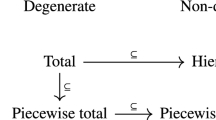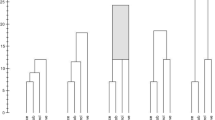Abstract
This paper focuses on how to perform unsupervised learning of tree structures in an information theoretic setting. The approach is a purely structural one and is designed to work with representations where the correspondences between nodes are not given, but must be inferred from the structure. This is in contrast with other structural learning algorithms where the node-correspondences are assumed to be known. The learning process fits a mixture of structural models to a set of samples using a minimum descriptor length formulation. The method extracts both a structural archetype that describes the observed structural variation, and the node-correspondences that map nodes from trees in the sample set to nodes in the structural model. We use the algorithm to classify a set of shapes based on their shock graphs.
Access this chapter
Tax calculation will be finalised at checkout
Purchases are for personal use only
Preview
Unable to display preview. Download preview PDF.
Similar content being viewed by others
References
Friedman, N., Koller, D.: Being Bayesian about Network Structure. Machine Learning (2002) (to appear)
Getoor, L., et al.: Learning Probabilistic models of relational structure. In: 8th Int. Conf. on Machine Learning (2001)
Heckerman, D., Geiger, D., Chickering, D.M.: Learning Bayesian networks: the combination of knowledge and statistical data. Machine Learning 20(3), 197–243 (1995)
Heap, T., Hogg, D.: Wormholes in shape space: tracking through discontinuous changes in shape. In: ICCV, pp. 344–349 (1998)
Jiang, X., Muenger, A., Bunke, H.: Computing the generalized mean of a set of graphs. In: Workshop on Graph-based Representations, GbR 1999, pp. 115–124 (2000)
Langley, P., Iba, W., Thompson, K.: An analysis of Bayesian classifiers. In: AAAI, pp. 223–228 (1992)
Luo, B., et al.: Clustering shock trees. In: CVPR, pp. 912–919 (2001)
Meilă, M.: Learning with Mixtures of Trees. PhD thesis, MIT (1999)
Riassen, J.: Stochastic complexity and modeling. Annals of Statistics 14, 1080–1100 (1986)
Sclaroff, S., Pentland, A.P.: Modal matching for correspondence and recognition. PAMI 17, 545–661 (1995)
Siddiqi, K., et al.: Shock graphs and shape matching. Int. J. of Comp. Vision 35 (1999)
Sebastian, T., Klein, P., Kimia, B.: Recognition of shapes by editing shock graphs. In: ICCV, vol. I, pp. 755–762 (2001)
Torsello, A., Hancock, E.R.: Efficiently computing weighted tree edit distance using relaxation labeling. In: Figueiredo, M., Zerubia, J., Jain, A.K. (eds.) EMMCVPR 2001. LNCS, vol. 2134, pp. 438–453. Springer, Heidelberg (2001)
Torsello, A., Hancock, E.R.: Matching and embedding through edit-union of trees. In: Heyden, A., Sparr, G., Nielsen, M., Johansen, P. (eds.) ECCV 2002. LNCS, vol. 2352, pp. 822–836. Springer, Heidelberg (2002)
Author information
Authors and Affiliations
Editor information
Editors and Affiliations
Rights and permissions
Copyright information
© 2003 Springer-Verlag Berlin Heidelberg
About this paper
Cite this paper
Torsello, A., Hancock, E.R. (2003). Graph Clustering with Tree-Unions. In: Petkov, N., Westenberg, M.A. (eds) Computer Analysis of Images and Patterns. CAIP 2003. Lecture Notes in Computer Science, vol 2756. Springer, Berlin, Heidelberg. https://doi.org/10.1007/978-3-540-45179-2_56
Download citation
DOI: https://doi.org/10.1007/978-3-540-45179-2_56
Publisher Name: Springer, Berlin, Heidelberg
Print ISBN: 978-3-540-40730-0
Online ISBN: 978-3-540-45179-2
eBook Packages: Springer Book Archive




